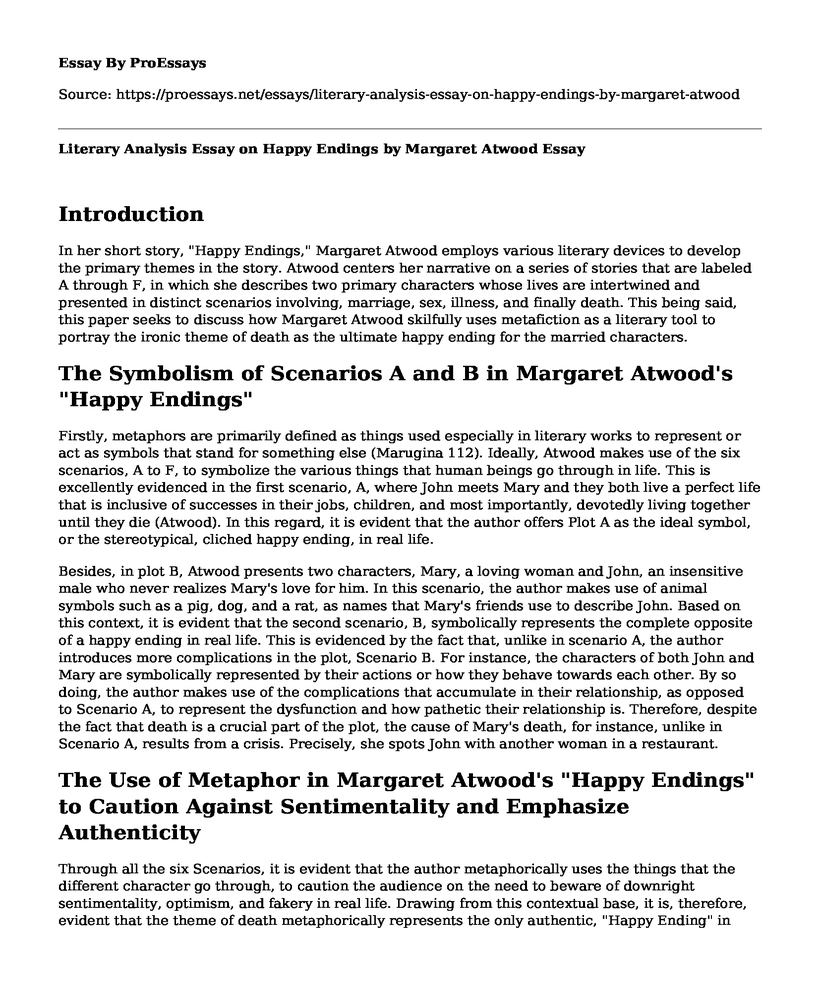Introduction
In her short story, "Happy Endings," Margaret Atwood employs various literary devices to develop the primary themes in the story. Atwood centers her narrative on a series of stories that are labeled A through F, in which she describes two primary characters whose lives are intertwined and presented in distinct scenarios involving, marriage, sex, illness, and finally death. This being said, this paper seeks to discuss how Margaret Atwood skilfully uses metafiction as a literary tool to portray the ironic theme of death as the ultimate happy ending for the married characters.
The Symbolism of Scenarios A and B in Margaret Atwood's "Happy Endings"
Firstly, metaphors are primarily defined as things used especially in literary works to represent or act as symbols that stand for something else (Marugina 112). Ideally, Atwood makes use of the six scenarios, A to F, to symbolize the various things that human beings go through in life. This is excellently evidenced in the first scenario, A, where John meets Mary and they both live a perfect life that is inclusive of successes in their jobs, children, and most importantly, devotedly living together until they die (Atwood). In this regard, it is evident that the author offers Plot A as the ideal symbol, or the stereotypical, cliched happy ending, in real life.
Besides, in plot B, Atwood presents two characters, Mary, a loving woman and John, an insensitive male who never realizes Mary's love for him. In this scenario, the author makes use of animal symbols such as a pig, dog, and a rat, as names that Mary's friends use to describe John. Based on this context, it is evident that the second scenario, B, symbolically represents the complete opposite of a happy ending in real life. This is evidenced by the fact that, unlike in scenario A, the author introduces more complications in the plot, Scenario B. For instance, the characters of both John and Mary are symbolically represented by their actions or how they behave towards each other. By so doing, the author makes use of the complications that accumulate in their relationship, as opposed to Scenario A, to represent the dysfunction and how pathetic their relationship is. Therefore, despite the fact that death is a crucial part of the plot, the cause of Mary's death, for instance, unlike in Scenario A, results from a crisis. Precisely, she spots John with another woman in a restaurant.
The Use of Metaphor in Margaret Atwood's "Happy Endings" to Caution Against Sentimentality and Emphasize Authenticity
Through all the six Scenarios, it is evident that the author metaphorically uses the things that the different character go through, to caution the audience on the need to beware of downright sentimentality, optimism, and fakery in real life. Drawing from this contextual base, it is, therefore, evident that the theme of death metaphorically represents the only authentic, "Happy Ending" in real life. Notably, the author emphasizes that human beings are bound to pass through various things, positive and negative. However, if one leads a life that is symbolized by the A version, they will definitely be a representation of what it means to have a "happy ending" since they achieved all the things they wanted to accomplish in life.
Conclusion
In a nutshell, the title of the story, "Happy Ending" is the representation of how a character's life was before they died. More fundamentally, at the end of the story, it appears that all the characters died and ended like in Scenario A. This, in essence, is a representation of what happens in real life, symbolizing all the happy endings that you achieve.
Works Cited
Atwood, Margaret. Happy Endings. 1983.
Marugina, Nadezda I. "Conceptual Metaphor as a Model Generating Literary Discourse." Procedia - Social and Behavioral Sciences, vol. 154, 2014, pp. 112-117.
Cite this page
Literary Analysis Essay on Happy Endings by Margaret Atwood. (2022, Jun 05). Retrieved from https://proessays.net/essays/literary-analysis-essay-on-happy-endings-by-margaret-atwood
If you are the original author of this essay and no longer wish to have it published on the ProEssays website, please click below to request its removal:
- Stopping by Woods on a Snowy Evening: Poem Analysis
- The Theme of Revenge in Hamlet Essay
- The Main Theme in Katherine Mansfield's Miss Brill Essay
- Essay Sample on The Wrath of Achilles and its Role in the Iliad
- Nawal El Saadawi Biography and Writings Essay Example
- Research Paper on Wordsworth Sonnets
- Essay Example on John and Mary's Happy Ending: Love, Marriage, Family, and Death







